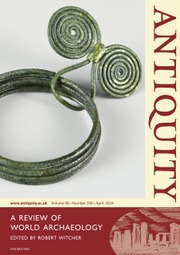Article contents
Newborn twins from prehistoric mainland Southeast Asia: birth, death and personhood
Published online by Cambridge University Press: 29 January 2015
Extract
Double infant burials in unusually high numbers occurred at Khok Phanom Di during a phase associated with immigration and some evidence of early agricultural practices. A study of their stratigraphic context and relative ages led to the interpretation that these were twins. Through an exploration of the medical and anthropological literature of twins, and in conjunction with their mortuary context, the authors conclude that these babies died of natural causes at, or soon after, birth.
- Type
- Research article
- Information
- Creative Commons
- The online version of this article is published within an Open Access environment subject to the conditions of the Creative Commons Attribution licence <http://creativecommons.org/licenses/by/4.0/>;.
- Copyright
- Copyright © Antiquity Publications Ltd. The online version of this article is published within an Open Access environment subject to the conditions of the Creative Commons Attribution licence <http://creativecommons.org/licenses/by/4.0/>;.
References
- 8
- Cited by




